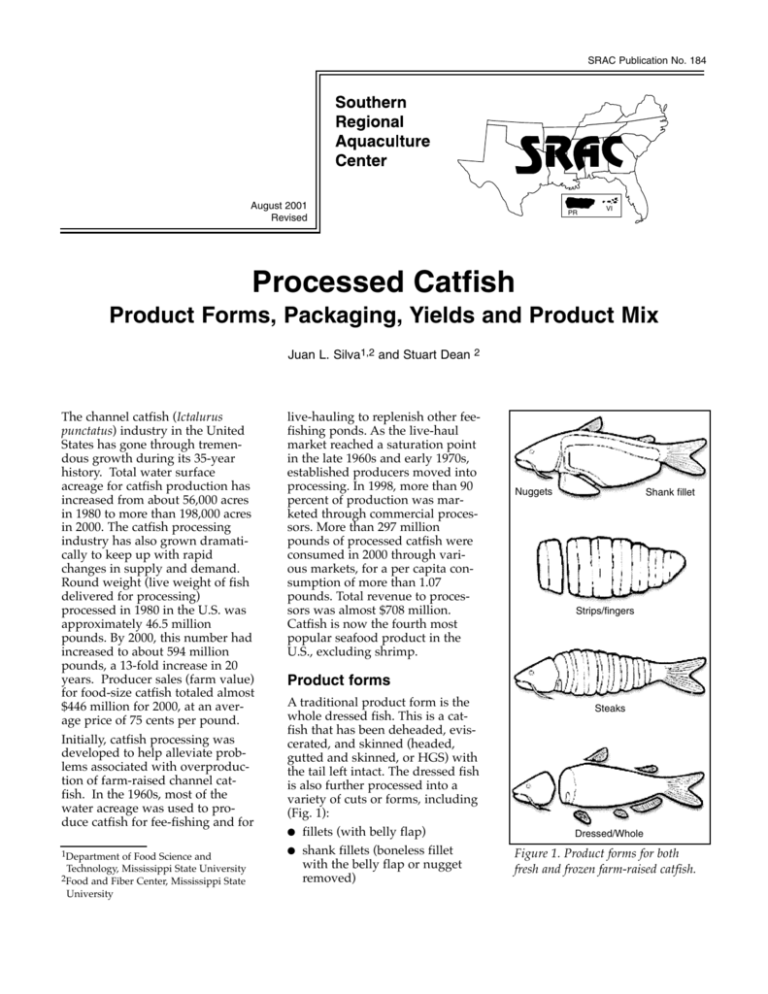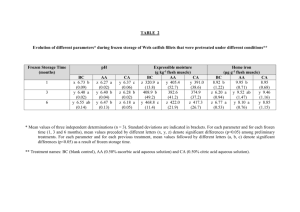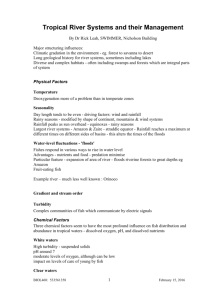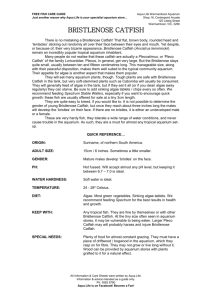Processed Catfish - Product forms, Packaging, Yields
advertisement

SRAC Publication No. 184 August 2001 Revised PR VI Processed Catfish Product Forms, Packaging, Yields and Product Mix Juan L. Silva1,2 and Stuart Dean The channel catfish (Ictalurus punctatus) industry in the United States has gone through tremendous growth during its 35-year history. Total water surface acreage for catfish production has increased from about 56,000 acres in 1980 to more than 198,000 acres in 2000. The catfish processing industry has also grown dramatically to keep up with rapid changes in supply and demand. Round weight (live weight of fish delivered for processing) processed in 1980 in the U.S. was approximately 46.5 million pounds. By 2000, this number had increased to about 594 million pounds, a 13-fold increase in 20 years. Producer sales (farm value) for food-size catfish totaled almost $446 million for 2000, at an average price of 75 cents per pound. Initially, catfish processing was developed to help alleviate problems associated with overproduction of farm-raised channel catfish. In the 1960s, most of the water acreage was used to produce catfish for fee-fishing and for 1Department of Food Science and Technology, Mississippi State University 2Food and Fiber Center, Mississippi State University 2 live-hauling to replenish other feefishing ponds. As the live-haul market reached a saturation point in the late 1960s and early 1970s, established producers moved into processing. In 1998, more than 90 percent of production was marketed through commercial processors. More than 297 million pounds of processed catfish were consumed in 2000 through various markets, for a per capita consumption of more than 1.07 pounds. Total revenue to processors was almost $708 million. Catfish is now the fourth most popular seafood product in the U.S., excluding shrimp. Nuggets Shank fillet Strips/fingers Product forms A traditional product form is the whole dressed fish. This is a catfish that has been deheaded, eviscerated, and skinned (headed, gutted and skinned, or HGS) with the tail left intact. The dressed fish is also further processed into a variety of cuts or forms, including (Fig. 1): ● fillets (with belly flap) ● shank fillets (boneless fillet with the belly flap or nugget removed) Steaks Dressed/Whole Figure 1. Product forms for both fresh and frozen farm-raised catfish. strips/fingers or fillet strips (boneless finger-size pieces cut from shank fillets) ● nuggets (belly flap section removed from fillet) ● steaks ● breaded fillets and nuggets ● heat-set, breaded fillets, portions and nuggets ● marinated fillets ● smoked (fillets and dressed fish) All these forms are marketed fresh and/or frozen. Processors also sell round-eviscerated catfish with the head still attached. Specialty products made their way into the marketplace in the late 1980s. Whole dressed catfish and fillets, coated or marinated with flavors and spices such as lemon-butter, cajun and mesquite, can be found in the seafood sections of many grocery stores. In the 1990s, products such as heatset, breaded nuggets, strips and fillets were introduced. Catfish gumbo and related products were also introduced. Smoked, dressed fish and fillets have become popular, although sales are still small because of safety hazards associated with these products. Preformed products such as patties and compacted products (trimmings formed into fillets or nuggets) may become popular as technology is developed. Other products which have been tested but are not readily available are catfish “corn dog,” sausage, tunaand salmon-style canned, sardinestyle canned, surimi and mince, nuggets with mince formed into patties, salted fillets, catfish roe, and others. Some by-products also have been used in making nonfood items (gelatin, belts, etc.). Offal, the by-product of catfish processing, also should be considered when discussing catfish product forms. Offal is sent to rendering plants for further processing into fish meal and fish oil (ingredients used in animal feed), or it is ground, cooled (or frozen), and then sold to pet food companies as an ingredient for canned ● pet foods. It is an advantage to the industry to be able to sell its solid waste rather than having to dispose of it. In addition, a low temperature enzyme process to produce hydrolysates from offal has been studied. Packaging Catfish products are sold by processors to institutional and retail markets. Most products are packaged and delivered fresh (icepacked), chill-packed, or individually quick frozen (IQF). The fresh product is packaged in a variety of ways to meet specifications of the customers. For example, whole dressed fish, shank fillets, fillets, steaks, strips and nuggets may be packaged in polyethylene on ice in a wax-coated, corrugated box. Fish, especially whole dressed fish, may be placed directly on ice and then covered with ice. When customers request ice pack, the fresh product is placed in wax-coated, corrugated boxes. Drainage holes at the bottom of the side are optional. Dry pack boxes do not have drainage holes. Depending on the product form, net weight in the boxes may be 10, 15, 20 or 30 pounds. However, each box is often packaged with 1 pound of product per pound of ice. If the product is going to be placed in a retail package at grocery stores, label inserts are also included in the corrugated boxes. The chill pack process consists of lowering the temperature of the product to between 25 and 30 oF to form a crust-freezing effect. Products such as whole dressed fish, fillets (including marinated fillets), nuggets and strips are often packaged and shipped chillpacked and then sold through retail outlets as fresh fish. This process extends shelf-life and protects the fish until it is thawed. The product is packaged in styrofoam trays, with soaker pads on the bottom, and covered with a polyethylene or PVC film. Trays are then placed in corrugated boxes without ice and stored or shipped in cold-storage form. Net weights of the boxes vary accord- ing to product form and customer requirements; however, basic net weights are 10, 15, 20 and 30 pounds. The boxed trays are then placed on pallets and moved into a blast freezer for a short period of time to achieve the crust freeze. They are then held in the cooler for shipment. This form of packaging is more often done now at the point of sale. Frozen product forms may be individually quick frozen (IQF) after injection (or tumbling) with phosphates. This is done with spiral or tunnel (cryogenic) freezers or with a blast freeze process. Most large processors use the IQF process. Products sold frozen include whole dressed fish, fillets, nuggets, strips, steaks and formed products. Breaded products, such as whole dressed fish, fillets, strips, nuggets and formed products, are also sold frozen. The individually frozen products are placed in polybags and packed in corrugated boxes with net weights usually of 10 and 15 pounds. In some cases, the frozen product is placed loose in the corrugated box and later packaged in styrofoam trays for retail outlets. Breaded and other specialty products may also be packaged in 2.5-pound polybags and 5-pound polybags and placed in 20-pound and 40-pound master cartons, respectively. These polybagged products are popular with frozen food retail outlets and food service institutions. Sealed, printed polybags containing breaded products ranging from 2 to 4 pounds are purchased by wholesale outlets for consumers. Breaded products are also sold, as are other fish products, in printed cartons in the retail freezer case. Another further processed catfish item is the enrobed product. This process consists of coating a product, especially fillets, with a seasoning and oil-base mixture and then individually freezing it. The enrobed fillets are then packed in clear plastic trays that contain individual compartments to keep the products from touching. Trays are usually packed according to fillet size, such as 4, 5 or 7 ounces, and are then placed in a polybag in a corrugated box. Normally, there are five trays with a total of 20 fillets to the box; however, this may vary according to the processor. Yields and product mix The yield from catfish processing is determined, to a large extent, by the product forms to which the processor is keying his marketing strategy. Harvest season and fish size influence yield also. Fish harvested in the winter may have lower yields because fish do not feed regularly when water temperatures are low. Fish harvested in the summer yield higher unless fed immediately prior to harvest; feed in the visceral cavity causes yield losses. As a fish grows, the head to body ratio decreases, yielding a higher proportion of dressed fish and fillets. A breakdown of approximate yields and product mix of various catfish product forms based on the conversion of 10,000 pounds of live catfish to processed products is shown in Figure 2. Further processing of catfish results in lower yields and more waste, so the processor’s cost per pound of marketable product increases accordingly. This factor, along with the marketing strategy of the processor and current consumer demands (the major factor), helps to determine the product mix for individual processors. Volumes given in the example in Figure 2 are based on 10,000 pounds of live fish converted to several product forms. A live fish dressing yield of 62 percent is assumed. As further processing occurs, a whole dressed fish is assumed to yield 70 percent fillets Live fish 100,000 lbs. 38% Total salable product = 53,010 pounds or 53 percent Total waste = 46,990 pounds or 47 percent 62% Offal waste 38,000 lbs. Dressed fish 62,000 lbs. 50% 50% Further processed 31,000 lbs. Marketed whole 31,000 lbs. 5% 95% For steaks 1,550 lbs. 10% Waste 155 lbs. For filleting 29,450 lbs. 90% Steaks 1,395 lbs. 70% 30% Fillets 20,615 lbs. Waste 8,835 lbs. 80% Shank fillets 16,492 lbs. 20% Nuggets 3,298 lbs. Figure 2. Catfish processing input-output chart illustrating a hypothetical product mix. 20% Fillet (w/nugget) 4,123 lbs. 80% Shank fillets 13,194 lbs. or 90 percent steaks. Fifty percent of the whole dressed fish is further processed into fillets, steaks and nuggets. Of this amount, 5 percent is converted to steaks and the remaining 95 percent to fillets. The amount of fillets can further be broken down, with 20 percent remaining as fillets and 80 percent being further processed into nuggets and shank fillets. Thus, from an input of 10,000 pounds of live fish, a total of 5,301 pounds, or 53 percent of the live weight, is converted into salable product. The catfish components of further processed items, such as breaded, marinated, and enrobed product forms, are included in the percentages throughout the diagram. Sales volume for fresh and frozen whole dressed fish, fillets and other catfish products sold in 2000 is shown in Table 1. For many years, sales of fresh products exceeded frozen. In 1985, a turning point in the industry occurred when the majority of sales came from frozen products. In 1987, frozen products represented 52 percent of sales by commercial processors. In 2000, this increased to 61 percent. In recent years, sales of whole catfish have been declining, from 46 percent of total sales in 1986 to 19 percent in 2000. On the other hand, sales have increased for value-added products such as breaded pieces and nuggets. References Aquaculture Outlook and Situation. National Economics Division, Economics and Statistics Service, U.S. Department of Agriculture. April 1981. Washington, D.C. Aquaculture Outlook. Economic Research Service, U.S. Department of Agriculture. October 1999. Washington, D.C. “Catfish Processing.” National Agricultural Statistics Service, Agricultural Statistics Board, U.S. Department of Agriculture. Washington, D.C. (http://usda.mainlib.cornell.edu/) “Catfish Production.” National Agricultural Statistics Service, Agricultural Statistics Board, U.S. Department of Agriculture. Washington, D.C. (http://usda.mainlib.cornell.edu/) “Top 10 Seafood and Fish Products.” Annual Per Capita Consumption Report for Seafood Products for 1998, National Fisheries Institute. Washington, D.C. Silva, J. L. and Ammerman, G. R. 1993. Composition, lipid changes and sensory evaluation of two sizes of channel catfish during frozen storage. Journal of Applied Aquaculture 2(2):39-49. Consumption increases Per capita consumption of catfish products has increased significantly over the last decade from 0.41 pounds in 1985 to 1.07 pounds in 1999, partly because of intensive marketing efforts within the industry. But rapid changes in consumption patterns and an apparent desire for new and exciting food products have been equally important. This is evidenced by the introduction of more than 10,000 new food products each year. The catfish industry has recognized these trends and has introduced value-added products to keep abreast of consumer demands. Some of these products (commercial or researched) are gumbo, sausage, corn dog, portion controlled and others. Food service/institutional sales are rising, so product development for this industry is critical for growth. Table 1. Sales volume of various product forms sold by U.S. catfish processors in 2000. Ice dressed2 pack1 Frozen1 Total sales1 % of total Ice pack % of total Frozen % of total 41,392 13,798 55,190 19 75 25 Fillet3 58,529 119,649 178,178 60 33 67 Other4 16,813 116,734 46,975 180,422 63,788 297,156 21 100 26 39 74 61 Whole Total Figures are based on data from the USDA, Agricultural Statistics Board “Catfish” 2000 publications. http://usda.mannlib.cornell.edu/ 1Thousand pounds 2Head, viscera and skin removed 3Includes fillets, shank and strip fillets; excludes any breaded product 4Includes all products not already reported, including weight of breading and added ingredients This publication was supported in part by USDA-CSREES Grant No. 98-38500-5865 from the United States Department of Agriculture, Southern Regional Aquaculture Center. This publication is an update of SRAC Publication No. 184 by the MSU Food and Fiber Center.






